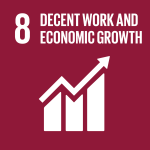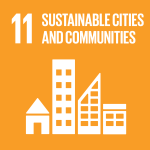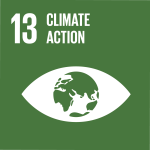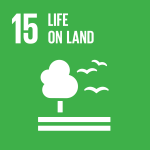
Suk Bdr Rai, 54, was chosen by his community as a "Chu Sungpa" or water guard. His job involves almost-daily inspections of the new irrigation scheme in Tsirang dzongkhag – about an hour’s walk from his home. "During monsoon, I have to make five to six trips in a day," Suk says. But he doesn't mind. “We couldn't be happier. For over 15 years, we didn’t grow rice because there was no water to irrigate our fields." Credit: UNDP Bhutan
To view the original photo essay on UNDP Climate Exposure, please click here.
In October 2021, just as farmers were preparing to harvest, unusually intense rainfall lashed several parts of Bhutan.
When the rains cleared, large swathes of paddy field were submerged under water. More than 2,500 acres of paddy were damaged – resulting in a production loss of as high as 2,264 metric tonnes.
Around 3,800 households were left struggling to make ends meet.
CARBON CONSEQUENCES
Despite being carbon negative, the Kingdom of Bhutan remains at the frontline of the climate crisis.
In fact, because of its mountainous terrain, fragile ecosystems, and dominance of agriculture, the landlocked Himalayan country is considered one of Asia Pacific’s most climate-vulnerable countries.
The impacts of global warming are already evident. Increased flood risk is a major concern with the majority of the country’s agricultural land and infrastructure in drainage basins. The availability of water has also become a growing concern, with remote areas experiencing shortages in dry years.
Climate models project a significant increase in the likelihood of heatwaves and droughts, likely to more severely impact lowland communities in the south. In the north, the threat of glacial lake outburst floods (GLOF) looms large over hundreds of communities.
Slow-onset changes and climate-related disasters have serious consequences, in particular for poorer rural families, and for a national budget already straining to meet competing development needs. Bhutan's rich biodiversity is also being placed under additional pressure.
The science indicates the risks are growing.
ADAPTING FOR THE FUTURE
Aware of the economic and development risks posed by climate change, but also the opportunities afforded by adaptation, the Royal Government of Bhutan has been taking action. In 2006, the government finalized its National Adaptation Programme of Action (NAPA). Conceived within the framework of the government’s sustainable development planning, the process identified key adaptation needs and priority projects, including foremost, addressing disaster risk and promoting climate-smart agriculture.
Since then, with finance from the Global Environment Facility and the backing of the UN Development Programme, Bhutan has been working to advance priority projects. The partnership has reaped real-world benefits for tens of thousands of Bhutanese, including in the most remote mountain communities.
The first NAPA project – targeted at reducing increasing risk from Glacial Lake Outburst Floods in the vulnerable Punakha-Wangdi and Chamkhar Valleys – successfully lowered the water level of the most dangerous glacial lakes in the country, Thormthomi, by 5 metres, also putting in place early warning systems to raise the alarm at the first sign of dam collapse. Communities’ disaster preparedness and response capacity were also improved.
A second NAPA project – focused on enhancing national, local and community capacity to prepare for and respond to climate-related disasters – addressed the threat of flooding to Bhutan’s largest industrial area (Phuentsholing and the adjoining industrial estate of Pasakha) and surrounds. The project also guided communities to find durable solutions to water-related challenges and set up 98 real-time and automated hydromet stations across the country, supporting improved forecasting, flood early warning and localized climate data.
Now, a third NAPA project is building the climate resilience of people, forests and wildlife. It is one of the biggest projects in the area of climate change and biodiversity conservation in Bhutan.
Five years into its implementation, despite some setbacks due to the COVID-19 pandemic, the third NAPA project is exceeding its goals, reaping significant benefits for the lives and livelihoods of people as well as achieving significant conservation milestones.
RESULTS FOR PEOPLE AND THE PLANET
Led by the Gross National Happiness Commission, the multi-dimensional project has been busy strengthening wildlife corridors as well as forests and agricultural systems, building the climate-resilience of rural livelihoods while encouraging communities to live in harmony with nature.
Since its inception in 2017 more than 102,000 people – almost half of them women – have already directly benefited from the introduction of sustainable land management, climate-resilient irrigation, low-emission livestock practices, an organic agriculture programme, improved forest resources management, and marketing infrastructure support.
Around 1,869 hectares of the project’s target 2,000 hectares have now been brought under sustainable management practices, directly benefiting 2,082 female farmers and preparing the ground for increased productivity.
In villages such as Bemji and Pang of Nubi Gewog in Trongsa, bench terracing and the planting of hedgerows have helped convert dry land into cultivable land. "Earlier, it was all slopes and ploughing was hard work. We can now use power tillers to plough the terraced fields," said Kunzang Choden, farmer from Bemji.
Twenty new biogas plants are supporting the energy needs of households while reducing time spent collecting traditional fuels, such as firewood, and reducing greenhouse gasses. "I'm now able to save money and time which I used to spend on collecting firewood and getting LPG cylinders from Zhemgang town," said Mr Penjor, a farmer from Berti, a small village in south-central Bhutan.
Meanwhile, construction of a climate-resilient road in landslide-prone Shingkhar Gewog in Zhemgang is well on track, with the project completing the first 17-kilometers (the remainder to be funded by the government), including stabilization of slopes to reduce risk of landslides and prevent damage, a proper drainage system to prevent rainwater run-off, improved soling, and a thicker layer of blacktopping.
Once the entire 31-kilometer stretch is complete, the travel time between Shingkhar and neighbouring Bardo Gewog will be reduced considerably, enabling communities to take their farm produce to the nearest market year-round, as well as access other essential public services such as health and education.
Meanwhile, pressurized piped irrigation channels constructed in select water-scarce villages are improving crop yield and changing the lives of farmers. For example, in Tsirang dzongkhag, central Bhutan, where an acute shortage of water had forced farmers to leave their land fallow for years, the completion of 7.2-km pressurized piped irrigation has enabled farmers to grow rice again, as well as off-season vegetables.
Additionally, the project is supporting the establishment of co-operatives, farm shops and processing units which create opportunities for farmers to market their produce. One impressive spinoff is the empowerment of women-led agriculture enterprises such as Takabi Women’s Group which produces and markets organic turmeric powder.
SUPPORTING ALL LIFE ON LAND
While building the climate resilience of agriculture and local livelihoods, the project has also been focused on improving the management of Bhutan’s forested landscapes and biodiversity. Key has been the strengthening of Protected Areas and Biological Corridors, thus securing ecosystem services for communities and conserving natural capital for national development.
Under this component, revised boundaries for Protected Areas and Biological Corridors have been endorsed by the government; a conservation management plan has been developed for Jigme Khesar Strict Nature Reserve; and two new Local Forest Management Plans – one under Dangchu and one under Nahi Gewog – have been developed. In total, the project has brought 162,500 hectares of forest under sustainable forest management, exceeding the target of 100,000 hectares.
Six local Forest Management Units and 29 Local Forest Management Plans have now also been approved, enabling communities to play a leading role in the scientific management of forest resources and achieving the project’s target of building institutional capacity for integrated landscape management.
Tigers, musk deer and snow leopards have been sighted in the Protected Areas and Biological Corridors, showing the value of improved SMART patrolling and camera trapping. The new sighting information will help parks devise or revise conservation plans.
LOOKING AHEAD
With the backing of UNDP and the Global Environment Facility, the third NAPA project has helped support rural families’ livelihoods in the wake of COVID-19, also providing a strong pillar for the government's goal of building back better from the pandemic.
The project will now focus on realizing the remainder of its objectives, including rolling out further agricultural marketing infrastructure, the formation of Water User Associations, and implementation of human-wildlife conflict management interventions.
This is how Bhutan is realizing climate-resilient people, forests and wildlife – through being at one with nature.
***
Adaptation remains a key priority for the Himalayan kingdom and with UNDP and the Green Climate Fund, the Gross National Happiness Commission is now also extending efforts to strengthen early warning and forecasting and climate-proof irrigation infrastructure, while the National Environment Commission is developing Bhutan’s first National Adaptation Plan with a focus on water expected to be completed and submitted to UNFCCC before COP27. Under the global Climate Promise, UNDP is helping Bhutan raise and realize its climate ambitions through supporting the implementation of its Nationally Determined Contribution (NDC).





